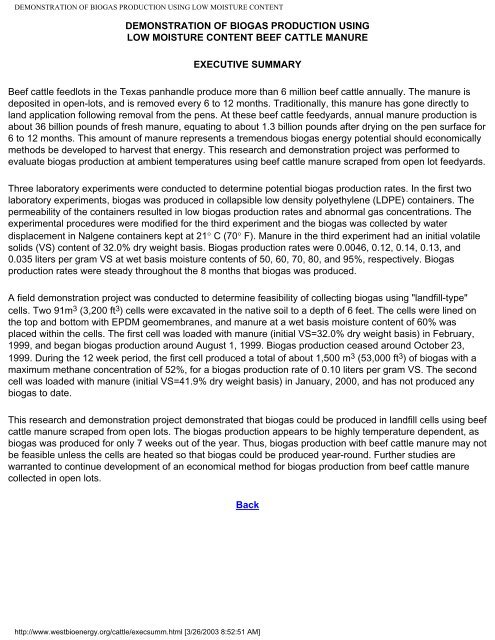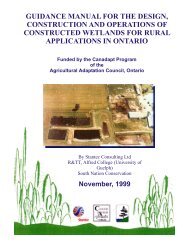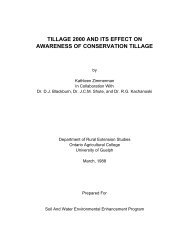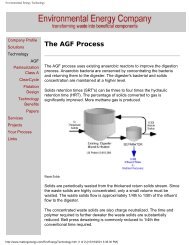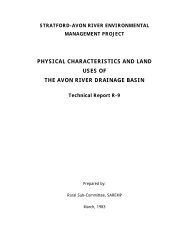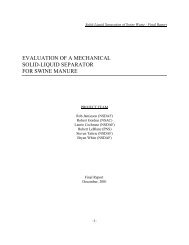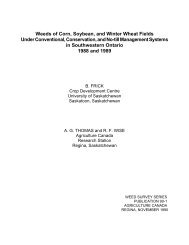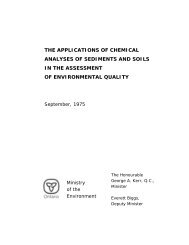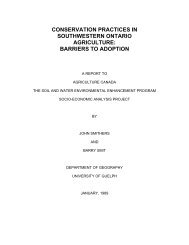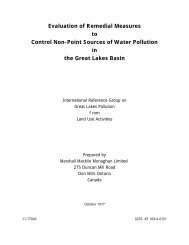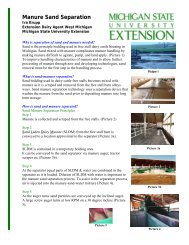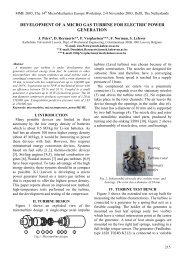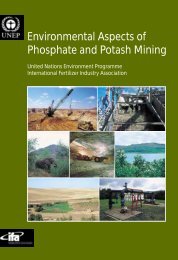demonstration of biogas production using low moisture content
demonstration of biogas production using low moisture content
demonstration of biogas production using low moisture content
You also want an ePaper? Increase the reach of your titles
YUMPU automatically turns print PDFs into web optimized ePapers that Google loves.
DEMONSTRATION OF BIOGAS PRODUCTION USING LOW MOISTURE CONTENT<br />
DEMONSTRATION OF BIOGAS PRODUCTION USING<br />
LOW MOISTURE CONTENT BEEF CATTLE MANURE<br />
EXECUTIVE SUMMARY<br />
Beef cattle feedlots in the Texas panhandle produce more than 6 million beef cattle annually. The manure is<br />
deposited in open-lots, and is removed every 6 to 12 months. Traditionally, this manure has gone directly to<br />
land application fol<strong>low</strong>ing removal from the pens. At these beef cattle feedyards, annual manure <strong>production</strong> is<br />
about 36 billion pounds <strong>of</strong> fresh manure, equating to about 1.3 billion pounds after drying on the pen surface for<br />
6 to 12 months. This amount <strong>of</strong> manure represents a tremendous <strong>biogas</strong> energy potential should economically<br />
methods be developed to harvest that energy. This research and <strong>demonstration</strong> project was performed to<br />
evaluate <strong>biogas</strong> <strong>production</strong> at ambient temperatures <strong>using</strong> beef cattle manure scraped from open lot feedyards.<br />
Three laboratory experiments were conducted to determine potential <strong>biogas</strong> <strong>production</strong> rates. In the first two<br />
laboratory experiments, <strong>biogas</strong> was produced in collapsible <strong>low</strong> density polyethylene (LDPE) containers. The<br />
permeability <strong>of</strong> the containers resulted in <strong>low</strong> <strong>biogas</strong> <strong>production</strong> rates and abnormal gas concentrations. The<br />
experimental procedures were modified for the third experiment and the <strong>biogas</strong> was collected by water<br />
displacement in Nalgene containers kept at 21° C (70° F). Manure in the third experiment had an initial volatile<br />
solids (VS) <strong>content</strong> <strong>of</strong> 32.0% dry weight basis. Biogas <strong>production</strong> rates were 0.0046, 0.12, 0.14, 0.13, and<br />
0.035 liters per gram VS at wet basis <strong>moisture</strong> <strong>content</strong>s <strong>of</strong> 50, 60, 70, 80, and 95%, respectively. Biogas<br />
<strong>production</strong> rates were steady throughout the 8 months that <strong>biogas</strong> was produced.<br />
A field <strong>demonstration</strong> project was conducted to determine feasibility <strong>of</strong> collecting <strong>biogas</strong> <strong>using</strong> "landfill-type"<br />
cells. Two 91m 3 (3,200 ft 3 ) cells were excavated in the native soil to a depth <strong>of</strong> 6 feet. The cells were lined on<br />
the top and bottom with EPDM geomembranes, and manure at a wet basis <strong>moisture</strong> <strong>content</strong> <strong>of</strong> 60% was<br />
placed within the cells. The first cell was loaded with manure (initial VS=32.0% dry weight basis) in February,<br />
1999, and began <strong>biogas</strong> <strong>production</strong> around August 1, 1999. Biogas <strong>production</strong> ceased around October 23,<br />
1999. During the 12 week period, the first cell produced a total <strong>of</strong> about 1,500 m 3 (53,000 ft 3 ) <strong>of</strong> <strong>biogas</strong> with a<br />
maximum methane concentration <strong>of</strong> 52%, for a <strong>biogas</strong> <strong>production</strong> rate <strong>of</strong> 0.10 liters per gram VS. The second<br />
cell was loaded with manure (initial VS=41.9% dry weight basis) in January, 2000, and has not produced any<br />
<strong>biogas</strong> to date.<br />
This research and <strong>demonstration</strong> project demonstrated that <strong>biogas</strong> could be produced in landfill cells <strong>using</strong> beef<br />
cattle manure scraped from open lots. The <strong>biogas</strong> <strong>production</strong> appears to be highly temperature dependent, as<br />
<strong>biogas</strong> was produced for only 7 weeks out <strong>of</strong> the year. Thus, <strong>biogas</strong> <strong>production</strong> with beef cattle manure may not<br />
be feasible unless the cells are heated so that <strong>biogas</strong> could be produced year-round. Further studies are<br />
warranted to continue development <strong>of</strong> an economical method for <strong>biogas</strong> <strong>production</strong> from beef cattle manure<br />
collected in open lots.<br />
Back<br />
http://www.westbioenergy.org/cattle/execsumm.html [3/26/2003 8:52:51 AM]


